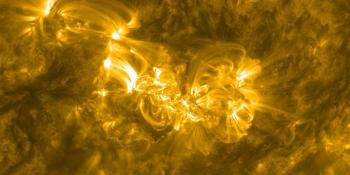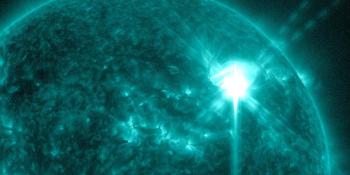Viendo archivo del domingo, 11 agosto 2002
Informe actividad solar
Any mentioned solar flare in this report has a scaling factor applied by the Space Weather Prediction Center (SWPC). Because of the SWPC scaling factor, solar flares are reported as 42% smaller than for the science quality data. The scaling factor has been removed from our archived solar flare data to reflect the true physical units.
Informe de actividad Solar-Geofísica 2002 Aug 11 2200 UTCPreparado por NOAA © SWPC y procesado por SpaceWeatherLive.com
Informe conjunto USAF/NOAA de actividad Solar y Geofísica
SDF Número 223 Publicado el 2200Z a las 11 Aug 2002IA. Análisis de regiones solares activas y de actividad desde 10-2100Z hasta 11-2100Z Solar activity remained at low levels. The two largest
x-ray flares of the period were optically uncorrelated: A C9.5
flare at 11/1147 UTC, and a C7.9 flare at 11/1801 UTC. LASCO
imagery revealed no evident CME activity following the first event,
and was unavailable for the second event, however neither event was
accompanied by any significant CME-related radio emissions. A
19-degree filament disappearance occurred near N28W51 at about
11/0700, close to the western end of a long filament channel that
extends to the northeast limb. No CME was evident in available
LASCO imagery following this event. Regions 61 (N07W28), 66
(N13E42), and newly numbered 69 (S08E77) were all sources of lesser
C-class activity. Region 61 appears to be undergoing an accelerated
decay in size and complexity. New Region 69 appears large and
complex in white light, but its limb proximity prevents a detailed
magnetic analysis. Three other regions were also numbered: 70
(N05W05), 71 (N11E68), and 72 (N18W23). All appear relatively
simply structured at present. 10cm flux experienced a rapid rise
with the appearance of the new regions.
IB. Pronóstico de la actividad solar
Solar activity is expected to be
predominantly low, but with a fair chance for isolated M-class
activity over the next three days, primarily due to new Region 69.
IIA. Resumen de la actividad geofísica 10-2100Z a 11-2100Z
The geomagnetic field was quiet to active. A trend toward elevated
solar wind speed and sustained southward Bz appeared to persist for
most of the day, and may indicate the early influence of expected
high speed stream effects.
IIB. Pronóstico de la actividad geofísica
The geomagnetic field is
expected to range from quiet to active conditions for the next three
days.
III. Probabilidades del evento 12 Aug a 14 Aug
| Clase M | 35% | 35% | 35% |
| Clase X | 01% | 01% | 01% |
| Protón | 01% | 01% | 01% |
| PCAF | green | ||
IV. Penticton 10.7cm flujo
Observado 11 Aug 172 Previsto 12 Aug-14 Aug 175/180/185 Media de 90 Días 11 Aug 164
V. Índices Geomagnéticos A
Observado Afr/Ap 10 Aug 013/016 Estimado Afr/Ap 11 Aug 013/018 Previsto Afr/Ap 12 Aug-14 Aug 012/012-015/015-012/012
VI. Probabilidades de Actividad Geomagnética 12 Aug a 14 Aug
| A. Latitudes Medias | |||
|---|---|---|---|
| Activo | 25% | 30% | 25% |
| Tormenta Menor | 10% | 10% | 10% |
| Tormenta Mayor-Severa | 01% | 01% | 01% |
| B. Latitudes Altas | |||
|---|---|---|---|
| Activo | 30% | 35% | 30% |
| Tormenta Menor | 10% | 10% | 10% |
| Tormenta Mayor-Severa | 01% | 01% | 01% |
< < Ir a la visión general diaria
Últimas noticias
Últimos mensajes del foro
AR3664 433[CME] AR 13664, flare flurry, CMEs galore, 2024-05-08/09 90all these X- and M- flares CME 08.05-09.05 7Sporadic E and Flare activity 23Unproven theories 387
Más temasApoye a SpaceWeatherLive.com!
Mucha gente viene a SpaceWeatherLive para seguir la actividad del Sol o previsión de aurora, pero con esta cantidad de tráfico se incrementan los costos del servidor. ¡Considere hacer una donación si disfruta de SpaceWeatherLive para que podamos mantener el sitio web en línea!

Hechos clima espacial
| Último evento clase X | 2024/05/09 | X2.2 |
| Último evento clase M | 2024/05/09 | M2.9 |
| Últimas tormentas geomagnéticas | 2024/05/06 | Kp5 (G1) |
| Días sin manchas | |
|---|---|
| Último día sin manchas | 2022/06/08 |
| Promedio de manchas solares mensuales | |
|---|---|
| abril 2024 | 136.5 +31.6 |
| Last 30 days | 163.9 +73.1 |


